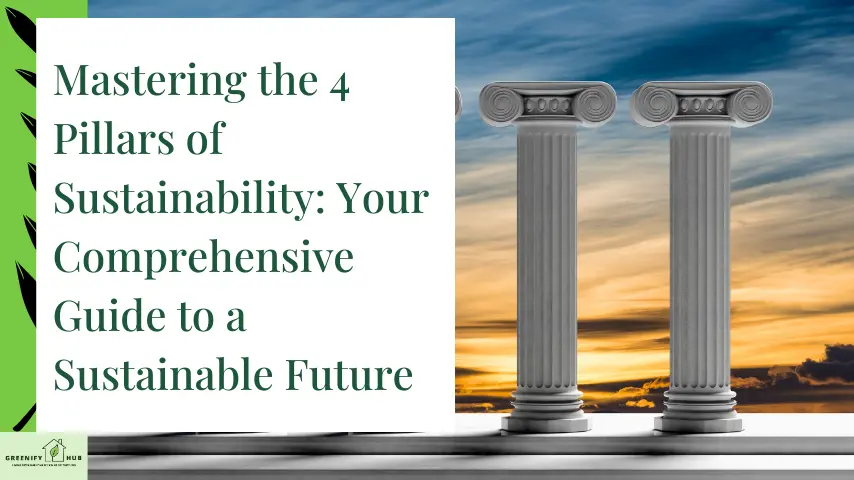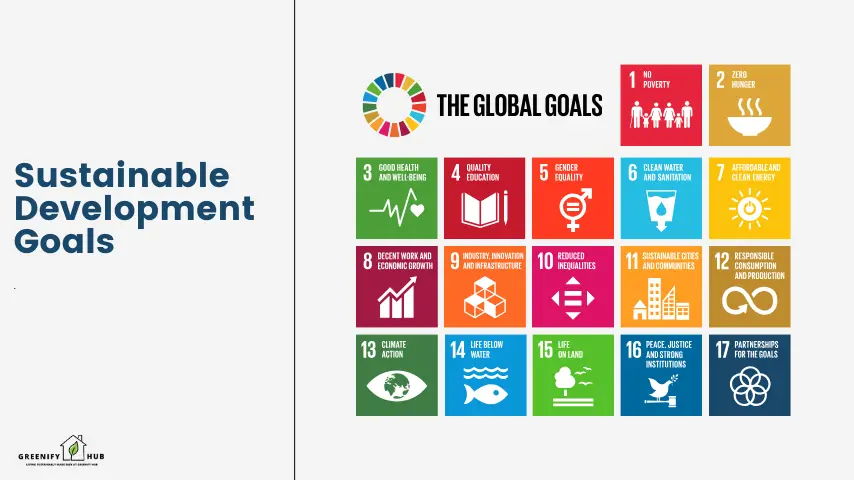Mastering the 4 Pillars of Sustainability: Your Comprehensive Guide to a Sustainable Future

Sustainability isn’t just a buzzword; it’s a blueprint for our future. But what exactly are the pillars of sustainability, and why do they matter?
Imagine a house. To stand strong, it needs four sturdy pillars. Sustainability is like that house, and its four pillars are environmental, economic, social, and human sustainability.
Environmental sustainability is about protecting our planet. Think of it as tending to a garden. We need to nurture the soil, plant trees, and avoid using harmful chemicals.
Economic sustainability focuses on balancing profit with planetary health. It’s like managing a household budget, but on a global scale.
Social sustainability aims to build healthier communities. Picture a neighborhood where everyone looks out for each other, regardless of their background.
Human sustainability invests in people’s wellbeing. It’s similar to nurturing a child, providing education, healthcare, and opportunities for growth.
These pillars work together to create a sustainable practice that ensures a better future for generations to come.
The four pillars of sustainability – environmental, economic, social, and human – form the foundation for creating a more sustainable world.

The Importance of Sustainability in Today’s World
Climate change isn’t a distant threat; it’s knocking on our door. From extreme weather events to rising sea levels, we’re already feeling its impact.
But it’s not just about the environment. Resource depletion threatens our way of life. Imagine a world where clean water is a luxury, not a basic right.
Sustainability offers a path forward. It’s our ticket to preserving the planet for future generations.
Think of it as a savings account for the Earth. We’re making deposits now to ensure there’s enough for tomorrow.
By embracing sustainable practices, we’re not just surviving; we’re thriving. We’re creating a world where both people and the planet can flourish.
Sustainability is crucial in addressing current challenges like climate change and resource depletion, ensuring a livable planet for future generations.
RELATED: Mastering the Three Es of Sustainability: A Comprehensive Guide for Businesses
Environmental Sustainability: Preserving Our Planet
Environmental sustainability is the cornerstone of a healthy planet. It’s about protecting our global ecosystem and ensuring it thrives for generations to come.
Imagine our Earth as a giant spaceship. We’re all astronauts on this vessel, and we need to keep it running smoothly. That means taking care of our air, water, and land.
Reducing Carbon Footprint
One key aspect is reducing our carbon footprint. This could mean opting for eco-friendly transportation methods. Instead of driving everywhere, consider biking or using public transport.
Energy Efficiency
Another crucial area is energy efficiency. Using energy-efficient appliances can make a big difference. It’s like turning off the lights when you leave a room, but on a larger scale.
Protecting Biodiversity
We also need to protect biodiversity. Our planet is home to millions of species, each playing a vital role in the ecosystem. Losing even one can have far-reaching consequences.
Sustainable Resource Management
Lastly, we need to manage our resources sustainably. This means using only what we need and ensuring resources can replenish themselves. It’s like fishing in a way that allows fish populations to recover.
By focusing on these areas, we can make significant strides in environmental protection and preservation.
Environmental sustainability involves reducing our carbon footprint, increasing energy efficiency, protecting biodiversity, and managing resources responsibly to preserve our planet’s health.
Practical Steps for Environmental Sustainability
Want to make a difference? Here are some simple yet effective steps:
1. Install solar panels: Harness the sun’s power for your energy needs.
2. Start a compost bin: Turn food waste into nutrient-rich soil.
3. Conduct an energy audit: Identify areas where you can save energy at home.
4. Reduce food waste: Plan meals, use leftovers creatively, and compost what you can’t eat.
Remember, small actions add up. Every step towards sustainability counts!
Practical steps like using solar energy, composting, conducting energy audits, and reducing food waste can significantly contribute to environmental sustainability.
RELATED: Unleashing Cultural Sustainability: 12 Key Strategies for Thriving Communities
Economic Sustainability: Balancing Profit and Planet
Economic sustainability isn’t just about making money; it’s about making money responsibly. It’s the art of balancing profit with planetary health.
Imagine running a lemonade stand. You want to make a profit, but not at the expense of using all the lemons in the world or polluting the neighborhood with plastic cups.
Sustainable Business Practices
Sustainable businesses think long-term. They invest in renewable energy, reduce waste, and create products that last. It’s like planting a fruit tree instead of buying fruit at the store.
Circular Economy
The circular economy is a key concept here. It’s about designing out waste and pollution, keeping products and materials in use, and regenerating natural systems.
Smart Technology
Smart home devices play a role too. They help us use resources more efficiently, saving both money and the environment.
By focusing on economic sustainability, we can drive economic growth without depleting our planet’s resources. It’s a win-win for both business and the environment.
Economic sustainability balances profit with environmental responsibility, incorporating sustainable business practices, circular economy principles, and smart technology for efficient resource use.
Social Sustainability: Building Healthier Communities
Social sustainability is about creating communities where everyone can thrive. It’s like building a neighborhood where all residents feel welcome, supported, and valued.
Quality of Life
The goal is to improve the quality of life for everyone. This means ensuring access to basic needs like food, shelter, and healthcare. But it goes beyond that.
Education System
A robust education system is crucial. It’s the key to unlocking opportunities and fostering innovation. Imagine a school where every child, regardless of background, gets a chance to shine.
Public Transport
Efficient public transport plays a vital role too. It’s not just about getting from A to B; it’s about connecting communities and reducing pollution.
Equal Importance
In a socially sustainable world, everyone’s voice matters equally. It’s like a choir where every voice contributes to the harmony, regardless of how loud or soft it is.
By focusing on these aspects, we can build communities that are not just surviving, but truly thriving.
Social sustainability focuses on improving quality of life, education, public services, and equality to create healthier, more inclusive communities.
RELATED: 4 Game-Changing Sustainable Business Practices for Lasting Impact
Human Sustainability: Investing in People
Human sustainability is all about investing in people. It’s like nurturing a garden, but instead of plants, we’re nurturing human potential.
Education Programs
Education is key. Imagine a world where everyone has access to quality learning, from preschool to professional development. This isn’t just about textbooks; it’s about equipping people with the skills they need to thrive.
Health and Wellbeing
Human welfare also means focusing on health. This includes access to healthcare, promoting mental wellbeing, and creating environments that support healthy lifestyles.
Innovation and Creativity
We need to foster environments that encourage innovative solutions. Think of it as creating a playground for ideas, where people feel free to experiment and create.
By investing in human sustainability, we’re not just improving individual lives; we’re building a stronger, more resilient society for all.
Human sustainability focuses on investing in education, health, and innovation to nurture human potential and create a more resilient society.
Integrating the 4 Pillars for Complete Sustainability
True sustainable living comes from integrating all four pillars. It’s like cooking a balanced meal – you need all the food groups to get the full nutritional benefit.
Environmental and economic sustainability work hand in hand. For instance, investing in renewable energy (environmental) can lead to long-term cost savings (economic).
Social and human sustainability are closely linked. Improving education (human) leads to stronger, more equitable communities (social).
While there are numerous challenges in achieving this balance, even simple changes can make a big difference. It’s about taking that first step towards a more sustainable future.
Complete sustainability requires integrating all four pillars, recognizing their interconnectedness and making balanced decisions that consider all aspects.
RELATED: Economic Sustainability Unveiled: 10 Key Principles for a Thriving Future
Sustainability in Business: A Competitive Advantage
In today’s market, sustainability isn’t just good for the planet – it’s good for business too. It’s becoming a key competitive advantage.
Consumer Demand
Consumers are increasingly favoring companies with sustainable practices. It’s like choosing a restaurant that sources local, organic ingredients over one that doesn’t.
Cost Savings
Sustainable practices often lead to cost savings in the long run. Energy-efficient operations, for example, can significantly reduce overhead costs.
Innovation Driver
Sustainability challenges drive innovation. Companies are finding creative solutions to reduce their environmental impact while improving their products.
Risk Mitigation
By focusing on sustainability, businesses can mitigate future risks related to resource scarcity or regulatory changes.
Embracing sustainability isn’t just about being ‘green’ – it’s about ensuring long-term success in a changing world.
Sustainability in business is becoming a competitive advantage, driving consumer preference, cost savings, innovation, and risk mitigation.
The Role of Technology in Advancing Sustainability
Technology is playing a pivotal role in our journey towards a more sustainable world. It’s like having a super-powered assistant in our quest for sustainability.
Smart home devices, for instance, are revolutionizing how we use energy. Imagine a house that automatically adjusts its temperature and lighting for optimal efficiency.
Innovative solutions are emerging in various sectors. From apps that help reduce food waste to AI systems that optimize renewable energy use, technology is offering new ways to tackle sustainability challenges.
These advancements are making it easier for individuals and businesses to reduce their environmental impact while often saving money in the process.
Technology, particularly smart devices and innovative solutions, is playing a crucial role in advancing sustainability efforts across various sectors.
RELATED: 10 Essential Steps to Mastering Social Sustainability: Transform Your Business and Society
Local Initiatives for Global Impact
Sustainability isn’t just about global policies; it’s about local action too. It’s like a pebble creating ripples in a pond – small local initiatives can have far-reaching effects.
Community Gardens
Consider community gardens. They’re not just about growing vegetables; they’re about building community, promoting food security, and reducing carbon footprints.
Plastic-Free Schools
Imagine a plastic-free school. It’s not just reducing waste; it’s educating a whole generation about sustainability.
Neighborhood Carpools
Local carpooling initiatives don’t just reduce emissions; they build connections within communities.
These local efforts, when multiplied across the world community, can create significant global change. It’s proof that we all have the power to make a difference.
Local sustainability initiatives, from community gardens to plastic-free schools, can create significant global impact when adopted widely.
Overcoming Challenges in Implementing Sustainability
Implementing sustainability isn’t always smooth sailing. There are numerous challenges to navigate, but with the right approach, they can be overcome.
Resistance to Change
One of the biggest hurdles is resistance to change. People are often comfortable with the status quo. It’s like trying to convince someone to try a new food – there’s often hesitation.
Upfront Costs
Another challenge is the upfront costs of sustainable solutions. Installing solar panels, for instance, requires an initial investment. But it’s important to consider the long-term savings.
Lack of Knowledge
Sometimes, the challenge lies in a lack of understanding. People might want to be more sustainable but don’t know where to start.
Local Context
What works in one place might not work in another. Sustainability solutions need to be adapted to local contexts, considering cultural, economic, and environmental factors.
The key to overcoming these challenges lies in education, patience, and practical application of sustainable principles. It’s about taking small, consistent steps towards a more sustainable future.
Overcoming sustainability challenges requires addressing resistance to change, considering long-term benefits, increasing education, and adapting solutions to local contexts.
The Future of Sustainability: Emerging Trends and Innovations
The world of sustainability is evolving rapidly. In recent years, we’ve seen exciting trends and innovations that promise a better future.
Circular Economy
One emerging trend is the circular economy. Imagine a world where nothing goes to waste – products are designed to be reused or recycled.
Green Energy Revolution
The green energy revolution is gaining momentum. From advanced solar tech to innovative wind turbines, renewable energy is becoming more efficient and accessible.
Sustainable Fashion
Even the fashion industry is getting a green makeover. From clothes made from recycled materials to rental fashion services, sustainable style is on the rise.
AI for Sustainability
Artificial Intelligence is offering innovative solutions for sustainability challenges. From optimizing energy use to predicting climate patterns, AI is becoming a powerful tool in our sustainability toolkit.
These trends show that a sustainable future isn’t just possible – it’s already in the making.
Emerging trends like circular economy, green energy advancements, sustainable fashion, and AI applications are shaping the future of sustainability.
RELATED: How Can you Be More Sustainable?
Taking Action: Your Path to a Sustainable Lifestyle
Embarking on a sustainable lifestyle might seem daunting, but remember: every journey begins with a single step. Here’s your starting point.
Assess Your Impact
Begin by assessing your current lifestyle. It’s like taking stock of your pantry before going grocery shopping.
Set Realistic Goals
Set achievable goals. Maybe start with reducing your plastic use or cutting down on energy consumption.
Educate Yourself
Keep learning about sustainability. Knowledge is power in the journey towards a greener life.
Spread the Word
Share your experiences with others. Your journey might inspire someone else to start theirs.
Remember, the essence of sustainable living isn’t about perfection – it’s about progress. Every small action contributes to a larger impact.
Take that first step today. The planet will thank you, and so will future generations.
Starting a sustainable lifestyle involves assessing your impact, setting realistic goals, continuous learning, and sharing your experiences with others.
RELATED: Environmental Sustainability Unveiled: Key Concepts Shaping Our Future
Global Cooperation for a Sustainable World
Achieving a sustainable world isn’t a solo mission – it requires global cooperation. It’s like a massive team project, where every country, organization, and individual has a role to play.
International Agreements
International agreements, like the Paris Climate Accord, set the stage for global action. These related intergovernmental fora create a framework for countries to work together.
SDG Synergy
The United Nations’ Sustainable Development Goals (SDGs) provide a roadmap for global sustainability. They encourage SDG synergy, where progress in one area supports advancements in others.

Diverse Collaboration
All kinds of organizations – from governments to NGOs, businesses to community groups – need to collaborate. It’s this diversity of perspectives and skills that will drive innovative solutions.
Together, we can create a more sustainable world. It’s not just about saving the planet – it’s about creating a better future for all of us.
Global cooperation, through international agreements, SDG synergy, and diverse collaboration, is crucial for achieving a sustainable world.
RELATED: Conservation and Sustainability: 10 Key Differences That Shape Our Planet’s Future
Conclusion
As we conclude our journey through the four pillars of sustainability, we hope you’ve gained a comprehensive understanding of how environmental, economic, social, and human sustainability intertwine to create a more sustainable world. By implementing the practical steps and innovative solutions discussed, you can play a pivotal role in shaping a better future for generations to come.
Remember, sustainability is not just about grand gestures; it’s about the simple changes we make in our daily lives. Whether it’s using energy-efficient appliances, supporting sustainable businesses, or participating in local initiatives, every action counts. The essence of sustainable living lies in balancing our needs with those of our planet and fellow humans.
As we face numerous challenges, from climate change to resource depletion, let’s embrace an action-focused approach. Start small, but think big. Your journey towards a more sustainable lifestyle begins now. Together, we can create a world where environmental protection, economic growth, and human welfare coexist harmoniously. Thank you for joining us on this crucial mission – let’s make sustainability our shared legacy.





